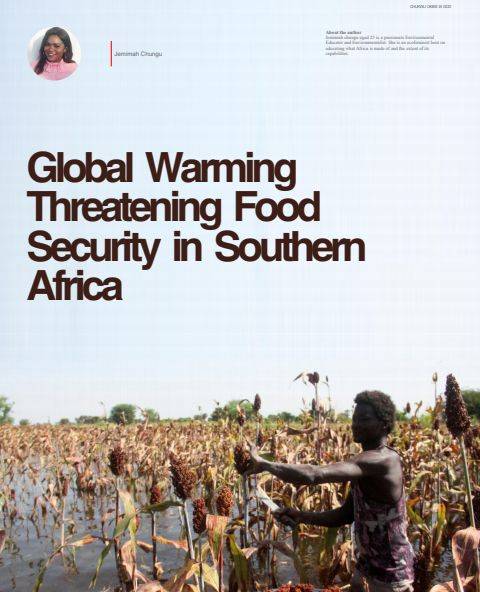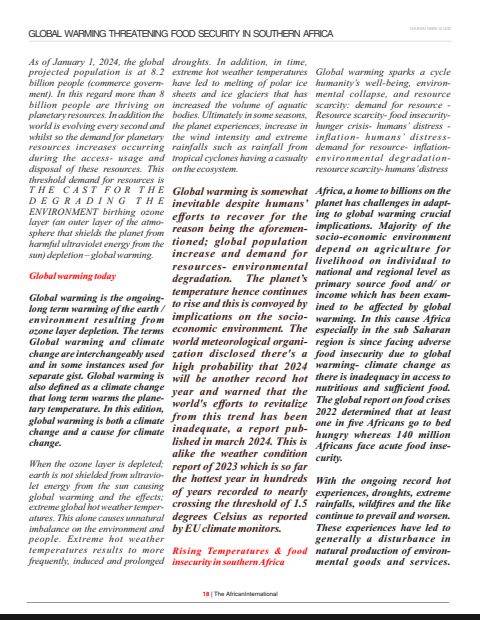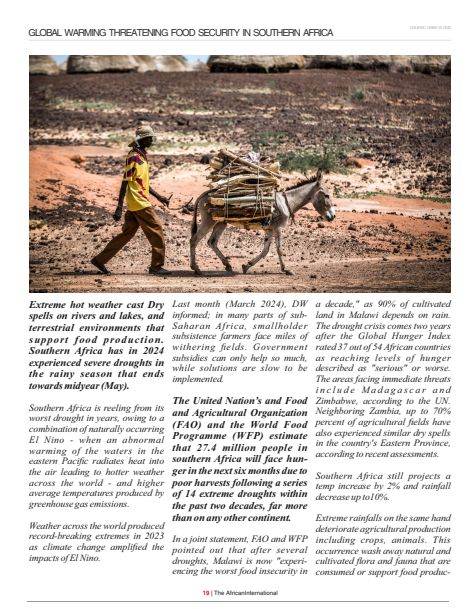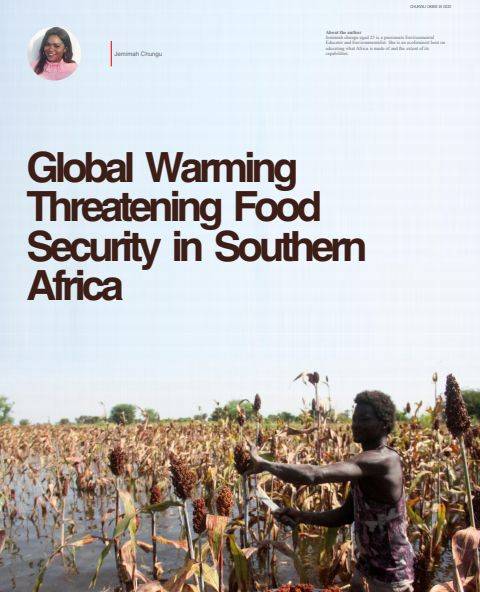By Jemimah Chungu

The African international Magazine -March/April edition 2024- Global Warming Threatening Food Security in Southern Africa
As of January 1, 2024, the global projected population is at 8.2 billion people (commerce government). In this regard more than 8 billion people are thriving on planetary resources. In addition the world is evolving every second and whilst so the demand for planetary resources increases occurring during the access- usage and disposal of these resources. This threshold demand for resources is THE CAST FOR THE DEGRADING THE ENVIRONMENT birthing ozone layer (an outer layer of the atmosphere that shields the planet from harmful ultraviolet energy from the sun) depletion – global warming.

The African international Magazine -March/April edition 2024- Global Warming Threatening Food Security in Southern Africa
Global warming today
Global warming is the ongoing- long term warming of the earth / environment resulting from ozone layer depletion. The terms Global warming and climate change are interchangeably used and in some instances used for separate gist. Global warming is also defined as a climate change that long term warms the planetary temperature. In this edition, global warming is both a climate change and a cause for climate change.
When the ozone layer is depleted; earth is not shielded from ultraviolet energy from the sun causing global warming and the effects; extreme global hot weather temperatures. This alone causes unnatural imbalance on the environment and people. Extreme hot weather temperatures results to more frequently, induced and prolonged droughts. In addition, in time, extreme hot weather temperatures have led to melting of polar ice sheets and ice glaciers that has increased the volume of aquatic bodies. Ultimately in some seasons, the planet experiences, increase in the wind intensity and extreme rainfalls such as rainfall from tropical cyclones having a casualty on the ecosystem.
Global warming is somewhat inevitable despite humans’ efforts to recover for the reason being the aforementioned; global population increase and demand for resources- environmental degradation. The planet’s temperature hence continues to rise and this is convoyed by implications on the socio-economic environment. The world meteorological organization disclosed there’s a high probability that 2024 will be another record hot year and warned that the world’s efforts to revitalize from this trend has been inadequate, a report published in march 2024. This is alike the weather condition report of 2023 which is so far the hottest year in hundreds of years recorded to nearly crossing the threshold of 1.5 degrees Celsius as reported by EU climate monitors.
Rising Temperatures & food insecurity in southern Africa
Global warming sparks a cycle humanity’s well-being, environmental collapse, and resource scarcity: demand for resource -Resource scarcity- food insecurity-hunger crisis- humans’ distress -inflation- humans’ distress- demand for resource- inflation- environmental degradation- resource scarcity- humans’ distress
Africa, a home to billions on the planet has challenges in adapting to global warming crucial implications. Majority of the socio-economic environment depend on agriculture for livelihood on individual to national and regional level as primary source food and/ or income which has been examined to be affected by global warming. In this cause Africa especially in the sub Saharan region is since facing adverse food insecurity due to global warming- climate change as there is inadequacy in access to nutritious and sufficient food. The global report on food crises 2022 determined that at least one in five Africans go to bed hungry whereas 140 million Africans face acute food insecurity.

The African International Magazine -March/April 2024 edition 2024- Global Warming Threatening Food Security in Southern Africa
With the ongoing record hot experiences, droughts, extreme rainfalls, wildfires and the like continue to prevail and worsen. These experiences have led to generally a disturbance in natural production of environmental goods and services. Extreme hot weather cast Dry spells on rivers and lakes, and terrestrial environments that support food production. Southern Africa has in 2024 experienced severe droughts in the rainy season that ends towards midyear (May).
Southern Africa is reeling from its worst drought in years, owing to a combination of naturally occurring El Nino – when an abnormal warming of the waters in the eastern Pacific radiates heat into the air leading to hotter weather across the world – and higher average temperatures produced by greenhouse gas emissions.
Weather across the world produced record-breaking extremes in 2023 as climate change amplified the impacts of El Nino.
Last month (March 2024), DW informed; in many parts of sub-Saharan Africa, smallholder subsistence farmers face miles of withering fields. Government subsidies can only help so much, while solutions are slow to be implemented.
The United Nation’s and Food and Agricultural Organization (FAO) and the World Food Programme (WFP) estimate that 27.4 million people in southern Africa will face hunger in the next six months due to poor harvests following a series of 14 extreme droughts within the past two decades, far more than on any other continent.
In a joint statement, FAO and WFP pointed out that after several droughts, Malawi is now “experiencing the worst food insecurity in a decade,” as 90% of cultivated land in Malawi depends on rain. The drought crisis comes two years after the Global Hunger Index rated 37 out of 54 African countries as reaching levels of hunger described as “serious” or worse. The areas facing immediate threats include Madagascar and Zimbabwe, according to the UN. Neighboring Zambia, up to 70% percent of agricultural fields have also experienced similar dry spells in the country’s Eastern Province, according to recent assessments.
Southern Africa still projects a temp increase by 2% and rainfall decrease up to10%
Extreme rainfalls on the same hand deteriorate agricultural production including crops, animals. This occurrence wash away natural and cultivated flora and fauna that are consumed or support food production. Examples of these are but not limited; trees and grass, and aquatic food (such as fish carbs and sardines), livestock, bush meat producing animals, fruits, spices, roots and herbs. In some instances extreme rainfalls washes away of land masses hence deteriorating the soil structure as well as human-made resources used for agriculture.
Back in 2022, southern Africa was hit by extreme Strong winds and heavy rainfall caused by `Tropical Storm Ana and Tropical Cyclone Batsirai respectively. The havoc led to extreme FOOD INSECURITY threat in the season due to loss of lives, damaged cropland and infrastructure, destroyed property, and resulted in livestock deaths. Affected countries in the region were Madagascar, Malawi, Mozambique, Zambia and Zimbabwe.
Furthermore, in February- march the following year (2023) A very Intense Tropical Cyclone Freddy, also referred to as Severe Tropical Cyclone Freddy, was an exceptionally long-lived, powerful, and deadly tropical cyclone that hit southern Africa and caused more food insecurity impact.
Similarly, environmental degradation of affected air quality by climate change and the same causes of climate change affects nutrients and chemical cycles such as; water cycle, oxygen cycle, carbon cycle, nitrogen cycle and phosphorus cycle. These help in agricultural production.
Global warming and the socio-economic environment
The economic environment is since affected by low yields of agricultural production recurring from climate change. Low production inevitably leads to high demand, low supply and ultimately inflation. This spells insufficient feeding of people thus poverty stretch. In other words, inflation leads to an economic measure of living on less than $1 / day which entails poverty or poor economic status.
Industrial production in the food sector is firmed by low agricultural production. Scarcity of these toil industrial produced foods and drinks such as breweries, fast foods, snacks, cereals, drinks and more. Yet, the demand of agricultural produced food by in industry also hinders access to staple food production such as maize meal.
The consequence of climate change on the economic environment is a toil on the Social environment as its purpose. A degraded environment spells resource scarcity, a derivation to deprived livelihood. In terms of food/ feeding, a degraded environment spells; hunger, poverty, malnutrition, distress and economy relegate at large. People in due course tend to be hungry, unhealthy, malnourished and more. Ultimately this leads to a degraded human resource as people die from unwellness and malnutrition.
Moreover; as a solution, firms resort to, artificially created drought resistant, artificial fertilizers, genetically modified foods (GMOs) among others to revitalize agricultural production- food security. However these are temporal solutions. They in the long run are responsible for health implications and unwellness on people as well as aggressive environmental implications such as pollution and latter climate change and food insecurity thereafter.
A degraded human resource only further leads food insecurity. This is because people are responsible for food productivity aside consumption.
Conclusion!
A healthy clean and green environment is the most dynamic step to addressing food insecurity in southern Africa and beyond. A clean and green environment can be reached by an informed and disciplined global community through enforcement of education systems and legal systems.
The Malawian political environment governed by President Lazarus Chakwera take and emphasis that sub-Saharan Africa must prioritize water resources and management and that It is important that irrigation is well-funded in order to do away with the persistent food insecurities. Chakwera launched a “mega farm” initiative in his country last year.


